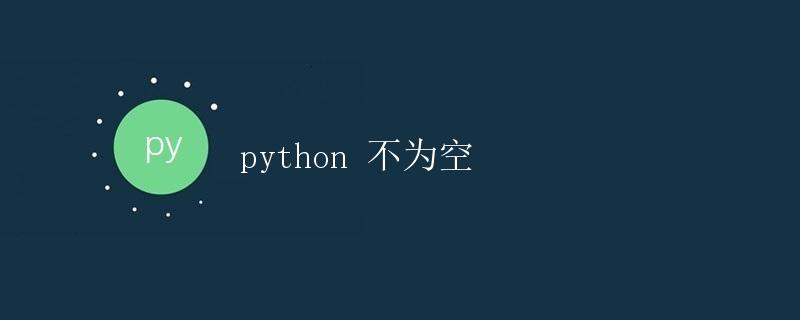Python 不为空

Python 是一种高级编程语言,广泛应用于各种领域,包括数据分析、机器学习、网站开发等。在编写 Python 代码的过程中,经常会遇到需要判断一个变量是否为空的情况。这篇文章将详细介绍在 Python 中如何判断一个变量是否为空。
什么是空值?
在 Python 中,有许多种方式表示空值。常见的空值包括 None、空字符串、空列表、空字典、空元组等。接下来我们将详细介绍这些空值及如何判断它们。
None
在 Python 中,None 表示一个空值,类似于其他编程语言中的 null 或 undefined。当一个变量没有被赋值时,它的值就是 None。可以通过比较操作符 is 来判断一个变量是否为 None。
x = None
if x is None:
print("x is None")
else:
print("x is not None")
运行结果:
x is None
空字符串
空字符串是指长度为 0 的字符串,可以通过比较操作符 == 来判断一个字符串是否为空。
s = ""
if s == "":
print("s is an empty string")
else:
print("s is not an empty string")
运行结果:
s is an empty string
空列表
空列表是指没有任何元素的列表,可以通过比较操作符 == 来判断一个列表是否为空。
lst = []
if lst == []:
print("lst is an empty list")
else:
print("lst is not an empty list")
运行结果:
lst is an empty list
空字典
空字典是指没有任何键值对的字典,可以通过比较操作符 == 来判断一个字典是否为空。
d = {}
if d == {}:
print("d is an empty dictionary")
else:
print("d is not an empty dictionary")
运行结果:
d is an empty dictionary
空元组
空元组是指没有任何元素的元组,在 Python 中用一对空的圆括号表示,可以通过比较操作符 == 来判断一个元组是否为空。
t = ()
if t == ():
print("t is an empty tuple")
else:
print("t is not an empty tuple")
运行结果:
t is an empty tuple
判断变量是否为空
在实际开发中,我们经常需要判断一个变量是否为空,这样可以避免出现空指针异常或者其他错误。下面我们将介绍如何判断不同类型的变量是否为空。
判断 None
在 Python 中,可以使用 is 操作符来判断一个变量是否为 None。下面是一个示例:
def check_none(var):
if var is None:
print("The variable is None")
else:
print("The variable is not None")
x = None
check_none(x)
运行结果:
The variable is None
判断字符串是否为空
可以使用判断字符串长度的方式来判断一个字符串是否为空。如果字符串的长度为 0,那么它就是一个空字符串。下面是一个示例:
def check_empty_string(s):
if len(s) == 0:
print("The string is empty")
else:
print("The string is not empty")
s = ""
check_empty_string(s)
运行结果:
The string is empty
判断列表是否为空
可以通过判断列表的长度是否为 0 来判断一个列表是否为空。如果列表长度为 0,那么它就是一个空列表。下面是一个示例:
def check_empty_list(lst):
if len(lst) == 0:
print("The list is empty")
else:
print("The list is not empty")
lst = []
check_empty_list(lst)
运行结果:
The list is empty
判断字典是否为空
可以通过判断字典的长度是否为 0 来判断一个字典是否为空。如果字典长度为 0,那么它就是一个空字典。下面是一个示例:
def check_empty_dict(d):
if len(d) == 0:
print("The dictionary is empty")
else:
print("The dictionary is not empty")
d = {}
check_empty_dict(d)
运行结果:
The dictionary is empty
判断元组是否为空
可以通过判断元组的长度是否为 0 来判断一个元组是否为空。如果元组长度为 0,那么它就是一个空元组。下面是一个示例:
def check_empty_tuple(t):
if len(t) == 0:
print("The tuple is empty")
else:
print("The tuple is not empty")
t = ()
check_empty_tuple(t)
运行结果:
The tuple is empty
总结
在 Python 中,有许多种方式表示空值,包括 None、空字符串、空列表、空字典、空元组等。通过本文的介绍,我们学习了如何判断这些空值,以及如何判断一个变量是否为空。在实际开发中,合理地判断变量是否为空可以有效避免出现错误,提高代码的健壮性。
 极客教程
极客教程